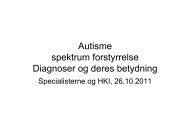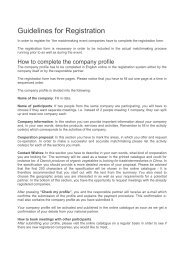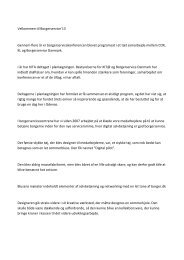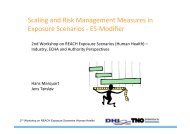Clusters are individuals - VDI/VDE-IT
Clusters are individuals - VDI/VDE-IT
Clusters are individuals - VDI/VDE-IT
Create successful ePaper yourself
Turn your PDF publications into a flip-book with our unique Google optimized e-Paper software.
officials consider evaluations as useful tools to improve the<br />
governance of a program and its effectiveness and efficiency.<br />
In this context many program officials consider formative<br />
evaluations as more useful than ex-post evaluations as they<br />
provide relevant information in the course of the program<br />
implementation which can be used for “real-time” improvements<br />
of the program. In contrast to this, ex-post evaluations<br />
<strong>are</strong> considered to be of more use while planning a new program<br />
or analyzing long-term effects of the support.<br />
The Innovation Network Denmark program and its program<br />
authority, the Danish Agency for Science, Technology<br />
and Innovation, is a very good example for using annual<br />
performance statistics and econometric impact studies for<br />
monitoring and evaluation purposes. Since 2006 the annual<br />
performance of the clusters that <strong>are</strong> supported through the<br />
program is measured through quantitative data, e.g. indicators<br />
on number of new services or products, number of participating<br />
companies and research institutions, number of<br />
collaboration projects, usage of services (e.g. matchmaking)<br />
offered by the cluster managements, etc. 26 The results of the<br />
annual performance assessment is not only used to monitor<br />
the program performance from a general angle, but also to<br />
identify specific weaknesses of the clusters which <strong>are</strong> then<br />
addressed by targeted measures developed by the program<br />
management (e.g. training courses or matchmaking activities).<br />
In 2011 the Danish Agency for Science, Technology<br />
and Innovation published an impact analysis of the program<br />
for the first time. This econometric analysis, which covered<br />
1,225 companies participating in the supported clusters,<br />
proved - just to give one example of the results - that the<br />
participation of a company in a cluster increases its capacity<br />
to innovate significantly within a short period of time (comp<strong>are</strong>d<br />
to companies that do not participate in a cluster). 27<br />
All programs, except the French program Grappe<br />
d’enterprises for which indicators <strong>are</strong> currently developed,<br />
have an indicator system in place to measure the performance<br />
of the program in terms of output, results and impact.<br />
The indicator systems differ between the programs in terms<br />
of the numbers of indicators that <strong>are</strong> used as well as in terms<br />
of comprehensiveness of the indicator set. There is no oneand-only<br />
indicator system that is characteristic for a cluster<br />
program as indicators always depend on the objectives of a<br />
specific program. Thus, which indicators <strong>are</strong> used and how<br />
they <strong>are</strong> measured depends on the individual program.<br />
While in principle the measurement of outputs and results of<br />
a cluster program is not difficult, it is challenging to measure<br />
26 Danish Agency for Science, Technology and Innovation, 2011: Innovation Network Denmark.<br />
Performance Accounts 2011, Innovation: Analyse og evaluierung 08/2011<br />
27 Danish Agency for Science, Technology and Innovation, 2011: The Impacts of Cluster Policy<br />
in Denmark. An Impact Study on Behavior and Economic Effects of Innovation Network Denmark<br />
the economic impact of a program. This applies both to the<br />
impact of the supported cluster initiatives - e.g. in terms of<br />
the cluster’s total R&D budget generated by all its members<br />
or the number of innovations that <strong>are</strong> an effect of the cluster<br />
initiatives’ activities - and the overall impact of the cluster<br />
support on the national economy. The challenge of measuring<br />
impacts lies in the complexity of the huge array of variables<br />
that decide on the actual effect of funding. Economic<br />
impacts can be measured e.g. through econometric impact<br />
analysis, but one has to be clear about the limitations: First,<br />
economic impacts of support programs can be measured<br />
only after a certain period of time. Normally the economic<br />
impact of activities can be measured after 5-7 years depending<br />
on the number of participating enterprises in the cluster<br />
with concrete registered activities. In other cases the<br />
economic impact using econometric impact analysis must<br />
wait longer and very probably sometimes until the program<br />
is already terminated. The results can in the latter case be<br />
used to verify the economic impact of the program, but not<br />
be used to redefine the strategy of the program.<br />
Second, due to the complexity of impact measurement a lot<br />
of different information has to be collected from the beneficiaries<br />
of the program. As surveys and interviews always require<br />
involvement of the beneficiaries in terms of resources<br />
one has to balance the cognitive interest in economic impacts<br />
of a program with the interest in reducing the burden<br />
for the beneficiaries that results from such comprehensive<br />
analysis. In this context, Denmark may serve as an international<br />
best-practice example for measuring economic impacts<br />
of public support by utilizing central civil and business<br />
registration systems to collect relevant information for such<br />
analysis. Although this reduces the burden for companies<br />
and organization involved in the analysis, it cannot fully replace<br />
specific surveys and other types of evaluations as those<br />
databases do not contain all data in detail that is usually<br />
required for the analysis or evaluation of a certain program.<br />
Many program officials experienced in the course of the<br />
program implementation that there is always room for improvement<br />
when it comes to monitoring and evaluation of<br />
a program and of cluster initiatives. Although most of them<br />
were satisfied with their approach and instruments they<br />
indicated that they <strong>are</strong> in a continuous search for a system<br />
that balances the interest in obtaining program governancerelated<br />
information with the interest in keeping the burdens<br />
for beneficiaries that derive from the participation in monitoring<br />
and evaluation as low as possible. However, none of<br />
them had a text-book-solution for the best system available.<br />
Benchmarking of cluster programs and cluster initiatives<br />
was frequently indicated by program officials as a very good<br />
53

















